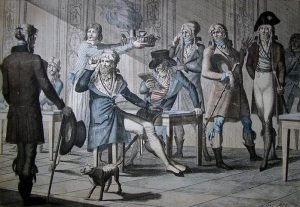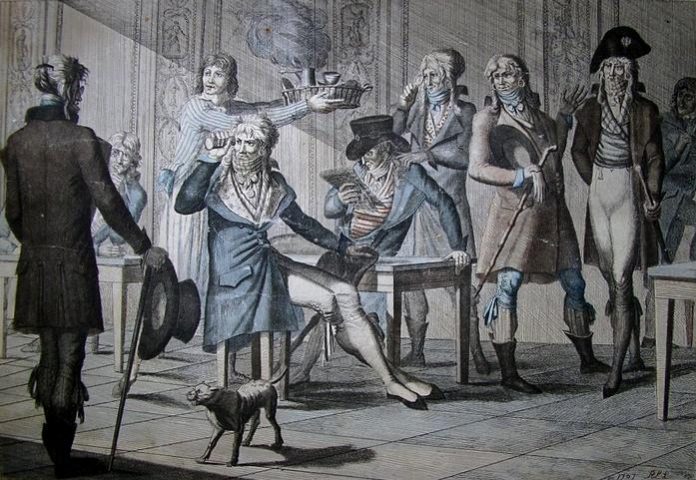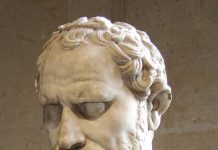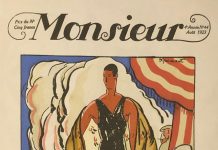As the author of this book tells us, “friendship was a hot topic during the Enlightenment.” Professor Jessica Fripp notes the formal definition of friendship in France, as given in Diderot’s Encyclopédie, was “nothing other than the practice of maintaining a decent and pleasant commerce with someone.” Fripp shows us in this fascinating book that the rather anodyne definition merely scratched the surface. In particular she focuses on an area that has hardly been studied before: “the crucial role friendship played in artists’ lives in eighteenth-century France.”
She probes the ways new conceptions of friendship arose through examining “the creation, display, and circulation of portraits.” Fripp does stray from her remit to some degree, by considering paintings that mixed what she terms “fantasy and sociability,” where both men and women would get dressed up in fanciful costumes, often from an earlier time. Fripp offers us a full-page image of someone dressed up in 1748 as The Grand Vizier. Later in the century pensioners (members) of the Academy, based in Paris, often studied in Rome, where Carnival was celebrated during an extended period of parades and balls. “These parades provided a forum for the artists to exhibit their talent. The skills that the pensioners displayed in designing their carnival costumes mirrored those that they possessed as artists.” I wish Fripp had taken the final logical step in this investigation, by looking at paintings of Incroyables (in English, Incredibles) who were prevalent in Paris in the last 5 years of the century. Taking a cue from incredible costumes and makeup that had been confined to carnival, these aristocrats adopted postures, costumes, fragrances and attitudes that were truly amazing. It was all played out in public as fantasy writ large. That they were painted is evident by the example given in this review (not in the book), but what was the interaction between them and the artists? In an otherwise marvellous book, this is not explored.
Fripp does, however, delve into not just how artists viewed their subjects, but how the subjects viewed the artists. In many cases she offers, the roles were reversible: artists painted each other. In Paris, employing a fellow art student as a model, wrapped in a piece of white fabric, was termed “drawing caricatures.”
The author highlights another most novel aspect of the use of caricature, which was often used as a memory device: an artist, making a quick sketch of a subject, often exaggerated certain bodily or facial aspects to remind him of critical elements that had to be incorporated in a final work. However, many of the examples she gives really are just caricatures. Another reason artists painted one another was necessity. “Artists in Rome were forbidden from copying after a nude model during Lent, and often turned to one another as models during this period.”
The role of poetry is also central to the early 18th century aspects of friendship. In 1708 the history painter Antoine Coypel read a poem to the Academy’s general assembly. It was so highly regarded that Coypel was invited expand on the commentary it contained. This resulted in a series of 19 lectures, over a period of eight years, which saw Coypel cover a range of topics including those most associated with friendship and art such as who was qualified to judge works of art (criticism) and ‘taste’. This leads the author to a look at an anonymous tract from 1779, by a “friend of the arts.” He “encounters two beautiful and fashionably dressed young people, who reveal themselves as the God of Taste and his sister, the Goddess of Criticism.” Fripp’s exploration of this obscure text is one of the book’s highlights. In one passage, “Taste throws himself in the arms of the narrator, complaining ‘You see how she treats one of my best friends.’ The intrepid narrator responds ‘Women are cruelly demanding.’” Artists certainly don’t like criticism! The key point Fripp zeroes in on, is that “The Goddess of Criticism lacks the faculty to judge works of art in the same manner as Taste does because she fixates on problematic details.”
In an era when history paintings were the most highly regarded (only history painters could attain the highest positions in the Academy), Fripp notes that portrait painting was often dismissed. But it began something we now live with on a daily basis: “Celebrity emerged as a new form.” Through a series of paintings (many reproduced in colour) and sculpture, the author does a superb job at teasing out all the nuances of friendship in its various guises. In an unusual perspective, she devotes a whole chapter to how this played out in the restricted feminine world, which was epitomized by the only two female painters of the late 18th century. On the male side, we have an extended discussion of portraits that depicted three men, typically all of them artists (one of whom usually included himself in the trio).
As an exploration of amitié, which we translate into English as friendship, this book is an essential text for understanding the social interaction of artists and their patrons in Enlightenment France.
Jessica Fripp is assistant professor of Art History at Texas Christian University.
Portraiture and Friendship in Enlightenment France is $70 from University of Delaware Press.














